Abstract
A novel superparamagnetic gold/halloysite nanotubes/Fe3O4 (Au/HNTs/Fe3O4) nanocomposite with coaxial structure was designed and fabricated by selective decoration of the inner lumen and the external wall of halloysite nanotubes (HNTs) based on the difference inside/outside surface charges. The structure and composition of Au/HNTs/Fe3O4 were characterized by transmission electron microscope, powder X-ray diffraction, and X-ray fluorescence. The results indicated that Au nanorods selectively generated within the lumen of HNTs, while Fe3O4 nanoparticles uniformly deposited on the external wall. It was particularly worth mentioning that the structure of HNTs was not destroyed in the preparation process of Au/HNTs/Fe3O4 nanocomposites. The catalytic activity of the as-prepared Au/HNTs/Fe3O4 was investigated for the reduction of 4-nitrophenol in the presence of NaBH4. The Au/HNTs/Fe3O4 nanocomposites exhibited excellent catalytic activity and cycling stability according to the kinetic data of the catalytic reduction reaction. In addition, the Au/HNTs/Fe3O4 catalysts can be easily manipulated by an external magnetic field for recycling.










Similar content being viewed by others
References
Bates TF, Hildebrand FA, Swineford A (1950) Morphology and structure of endellite and halloysite. Am Mineral 35:463–484
Lvov YM, Shchukin DG, Mhwald H, Price RR (2008) Halloysite clay nanotubes for controlled release of protective agents. ACS Nano 2:814–820
Yuan P, Southon PD, Liu ZW, Green MER, Hook JM, Antill SJ, Kepert CJ (2008) Functionalization of halloysite clay nanotubes by grafting with γ-aminopropyltriethoxysilane. J Phys Chem C 112:15742–15751
Liu MX, Guo BC, Du ML, Cai XJ, Jia DM (2007) Properties of halloysite nanotube-epoxy resin hybrids and the interfacial reactions in the systems. Nanotechnology 18:455703
Mu B, Zhao MF, Liu P (2008) Halloysite nanotubes grafted hyperbranched (co)polymers via surface-initiated self-condensing vinyl (co)polymerization. J Nanopart Res 10:831–838
Xie YF, Qian DY, Wu DL, Ma XF (2011) Magnetic halloysite nanotubes/iron oxide composites for the adsorption of dyes. Chem Eng J 168:959–963
Zhu H, Du ML, Zou ML, Xu CS, Fu YQ (2012) Green synthesis of Au nanoparticles immobilized on halloysite nanotubes for surface-enhanced Raman scattering substrates. Dalton Trans 41:10465–10471
Li CP, Wang JQ, Feng SQ, Yang ZL, Ding SJ (2013) Low-temperature synthesis of heterogeneous crystalline TiO2-halloysite nanotubes and their visible light photocatalytic activity. J Mater Chem A 1:8045–8054
Xing WN, Ni L, Huo PW, Lu ZY, Liu XL, Luo YY, Yan YS (2012) Preparation high photocatalytic activity of CdS/halloysite nanotubes (HNTs) nanocomposites with hydrothermal method. Appl Surf Sci 259:698–704
Wang Q, Zhang JP, Wang AQ (2013) Spray-dried magnetic chitosan/Fe3O4/halloysite nanotubes/ofloxacin microspheres for sustained release of ofloxacin. RSC Adv 3:23423–23431
Kelly H, Deasy P, Ziaka E, Claffey N (2004) Formulation and preliminary in vivo dog studies of a novel drug delivery system for the treatment of periodontitis. Int J Pharm 274:167–183
Lvov Y, Price R (2008) Halloysite nanotubules a novel substrate for the controlled delivery of bioactive molecules bio-inorganic hybrid nanomaterials. Wiley, Berlin, pp 440–478
Suh Y, Kil D, Chung K, Abdullayev E, Lvov Y, Mongayt D (2011) Natural nanocontainer for the controlled delivery of glycerol as a moisturizing agent. J Nanosci Nanotechnol 11:661–665
Lee Y, Jung GE, Cho SJ, Geckeler KE, Fuchs H (2013) Cellular interactions of doxorubicin-loaded DNA-modified halloysite nanotubes. Nanoscale 5:8577–8585
Tan DY, Yuan P, Annabi-Bergaya F, Yu HG, Liu D, Liu HM, He HP (2013) Natural halloysite nanotubes as mesoporous carriers for the loading of ibuprofen. Micropor Mesopor Mater 179:89–98
Abdullayev E, Lvov Y (2010) Clay nanotubes for corrosion inhibitor encapsulation: release control with end stoppers. J Mater Chem 20:6681–6687
Chen W, Pan XL, Bao XH (2007) Effect of confinement in carbon nanotubes on the activity of Fischer-Tropsch iron catalyst. J Am Chem Soc 129:7421–7426
Pan XL, Bao XH (2011) The effects of confinement inside carbon nanotubes on catalysis. Acc Chem Res 44:553–562
Friedrich H, Guo SJ, de Jongh PE, Pan XL, Bao XH, de Jong KP (2011) A quantitative electron tomography study of ruthenium particles on the interior and exterior surfaces of carbon nanotubes. ChemSusChem 4:957–963
Shchukin D, Price R, Lvov Y (2005) Halloysite nanotubes as biomimetic nanoreactors. Small 1:510–513
Yah WO, Xu H, Soejima H, Ma W, Lvov Y, Takahara A (2012) Biomimetic dopamine derivative for selective polymer modification of halloysite nanotube lumen. J Am Chem Soc 134:12134–12137
Pan JM, Hang H, Dai XH, Dai JD, Huo PW, Yan YS (2012) Switched recognition and release ability of temperature responsive molecularly imprinted polymers based on magnetic halloysite nanotubes. J Mater Chem 22:17167–17175
Abdullayev E, Joshi A, Wei WB, Zhao YF, Lvov Y (2012) Enlargement of halloysite clay nanotube lumen by selective etching of aluminum oxide. ACS Nano 6:7216–7226
Abdullayev E, Sakakibara K, Okamoto K, Wei WB, Ariga K, Lvov Y (2011) Natural tubule clay template synthesis of silver nanorods for antibacterial composite coating. ACS Appl Mater Interface 3:4040–4046
Wang Q, Zhang JP, Zheng YA, Wang AQ (2014) Adsorption and release of ofloxacin from acid- and heat-treated halloysite. Colloid Surf B 113:51–58
Mu B, Liu P, Dong Y, Lu CY, Wu XL (2010) Superparamagnetic pH-sensitive multilayer hybrid hollow microspheres for targeted controlled release. J Polym Sci A 48:3135–3144
Davies MB, Partridge DA, Austin J (1991) Vitamin C: its chemistry and biochemistry. Royal Society of Chemistry, Cambridge
Bradshaw MP, Barril C, Clark AC, Prenzler PD, Scollary GR (2011) Ascorbic acid: a review of its chemistry and reactivity in relation to a wine environment. Crit Rev Food Sci 51:479–498
Lin YT, Liang CJ (2013) Carbon tetrachloride degradation by alkaline ascorbic acid solution. Environ Sci Technol 47:3299–3307
Zhu YH, Stubbs LP, Ho F, Liu RZ, Ship CP, Maguire JA, Hosmane NS (2010) Magnetic nanocomposites: a new perspective in catalysis. ChemCatChem 2:365–374
Joussein E, Petit S, Churchman J, Theng B, Righi D, Delvaux B (2005) Halloysite clay minerals-a review. Clay Miner 40:383–426
Barrientos-Ramirez S, Ramos-Fernandez EV, Silvestre-Albero J, Speulveda A, Pastor-Blas MM, Gonzalez-Montiel A (2009) Use of nanotubes of natural halloysite as catalyst support in the atom transfer radical polymerization of methyl methacrylate. Micropor Mesopor Mater 120:132–140
Deng Y, White GN, Dixon JB (2002) Effect of structural stress on the intercalation rate of kaolinite. J Colloid Interf Sci 250:379–393
Brindley GW (1980) Order-disorder in clay mineral structures. In: Brindley GW, Brown G (eds) Crystal structures of clay minerals and their X-ray identification. Mineralogist Society, London
Sharma MK, Ambolikar AS, Aggarwal SK (2012) Electrochemical synthesis of gold nanorods in track-etched polycarbonate membrane using removable mercury cathode. J Nanopart Res 14:1094–1103
Zhang M, Cushing BL, O’Connor CJ (2008) Synthesis and characterization of monodisperse ultra-thin silica-coated magnetic nanoparticles. Nanotechnology 19:085601
Mu B, Kang YR, Wang AQ (2013) Preparation of a polyelectrolyte-coated magnetic attapulgite composite for the adsorption of precious metals. J Mater Chem A 1:4804–4811
Jenkins R, Gould RW, Gedcke D (1995) Quantitative X-ray spectrometry, 2nd edn. Marcel Dekker Inc, New York
Sitepu H, Kapylova MG, Quirt DH, Cutler JN, Kotzer TG (2005) Synchrotron micro-X-ray fluorescence analysis of natural diamonds: first steps in identification of mineral inclusions in situ. Am Miner 90:1740–1747
Zhang W, Tan FT, Wang W, Qiu XL, Qiao XL, Chen JG (2012) Facile, template-free synthesis of silver nanodendrites with high catalytic activity for the reduction of p-nitrophenol. J Hazard Mater 217–218:36–42
Liou RM, Chen SH, Huang CH, Lai CL, Shih CY, Chang JS, Hung MY (2010) Catalytic wet peroxide oxidation of p-nitrophenol by Fe(III) supported on resin. Water Sci Technol 62:1879–1887
Liu B, Li S, Zhao YJ, Wu WF, Zhang XX, Gu XY, Li RH, Yang SG (2010) Enhanced degradation of 4-nitrophenol by microwave assisted Fe/EDTA process. J Hazard Mater 176:213–219
Wang X, Zhao HM, Quan X, Zhao YZ, Chen S (2009) Visible light photoelectrocatalysis with salicylic acid-modified TiO2 nanotube array electrode for p-nitrophenol degradation. J Hazard Mater 166:547–552
Liu X, Cheng HM, Cui P (2014) Catalysis by silver nanoparticles/porous silicon for the reduction of nitroaromatics in the presence of sodium borohydride. Appl Surf Sci 292:695–701
Mu B, Wang Q, Wang AQ (2013) Preparation of magnetic attapulgite nanocomposite for the adsorption of Ag+ and application for catalytic reduction of 4-nitrophenol. J Mater Chem A 1:7083–7090
Du XY, He J, Zhu J, Sun LJ, An SS (2012) Ag-deposited silica-coated Fe3O4 magnetic nanoparticles catalyzed reduction of p-nitrophenol. Appl Surf Sci 258:2717–2723
Tang SC, Vongehr S, Meng XK (2010) Carbon spheres with controllable silver nanoparticle doping. J Phys Chem C 114:977–982
Du Y, Chen H, Chen R, Xu N (2004) Synthesis of p-aminophenol from p-nitrophenol over nano-sized nickel catalysts. Appl Catal A 277:259–264
Mei Y, Lu Y, Polzer F, Ballauff M (2007) Catalytic activity of palladium nanoparticles encapsulated in spherical polyelectrolyte brushes and core-shell microgels. Chem Mater 19:1062–1069
Zhang P, Shao C, Zhang Z, Zhang M, Mu J, Guo Z, Liu Y (2011) In situ assembly of well-dispersed Ag nanoparticles (AgNPs) on electrospun carbon nanofibers (CNFs) for catalytic reduction of 4-nitrophenol. Nanoscale 3:3357–3363
Jana S, Ghosh SK, Nath S, Pande S, Praharaj S, Panigrahi S, Basu S, Endo T, Pal T (2006) Synthesis of silver nanoshell-coated cationic polystyrene beads: a solid phase catalyst for the reduction of 4-nitrophenol. Appl Catal A 313:41–48
Author information
Authors and Affiliations
Corresponding author
Rights and permissions
About this article
Cite this article
Mu, B., Zhang, W. & Wang, A. Facile fabrication of superparamagnetic coaxial gold/halloysite nanotubes/Fe3O4 nanocomposites with excellent catalytic property for 4-nitrophenol reduction. J Mater Sci 49, 7181–7191 (2014). https://doi.org/10.1007/s10853-014-8426-6
Received:
Accepted:
Published:
Issue Date:
DOI: https://doi.org/10.1007/s10853-014-8426-6




